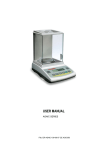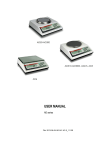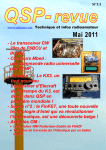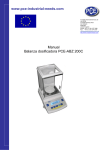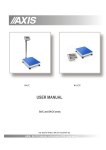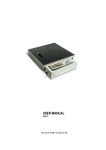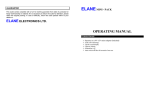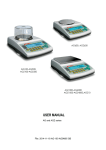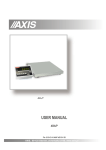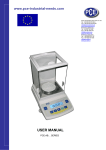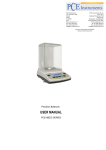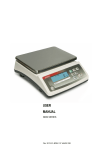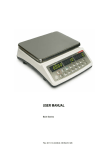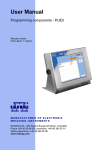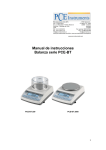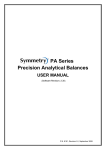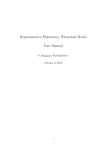Download user manual
Transcript
USER MANUAL AGN/C SERIES File: 2014-11-20 ER-AGNC-109 AGC073 GB 2 USER MANUAL ____________________________________________________________________________________________________________________ Contents: 1. General description................................................................................................................................ 3 2. Completeness ........................................................................................................................................ 3 3. Safety rules............................................................................................................................................ 4 4. Technical data ....................................................................................................................................... 5 5. General balance description .................................................................................................................. 6 6. Keys and indicators ............................................................................................................................... 7 7. Preparing working environment ............................................................................................................. 8 8. Preparing balance to work ..................................................................................................................... 9 9. General operation principles ................................................................................................................ 10 10. Start-up .............................................................................................................................................. 11 11. Internal calibration ............................................................................................................................. 11 12. Checking the balance ........................................................................................................................ 13 13. Connecting the balance to computer or printer .................................................................................. 13 14. Basic balance functions ..................................................................................................................... 15 14.1 Simple weighing............................................................................................................................... 15 14.2 Weighing with tare ........................................................................................................................... 16 15. Special functions................................................................................................................................ 17 15.1 Menu customization function (ACtIV) ............................................................................................... 18 15.2 Autozeroing function (AutOtAr) ....................................................................................................... 19 15.3 Pieces counting function (PCS) ....................................................................................................... 20 15.4 Function for changing weighing units grams/carats/pounds (UnIt) .................................................. 21 15.5 Percent function (PErCEnt).............................................................................................................. 22 15.6 Function for calibration with external weight / calibration options (CALIbr) ...................................... 23 15.7 Function for setting serial ports mode and parameters (Port) .......................................................... 27 15.8 Printout configuration (PrInt) ............................................................................................................ 28 15.9 Backlighting setting (b_LIGHt) ......................................................................................................... 30 15.10 Weigh summation (rECIPE) ........................................................................................................... 31 15.11 Function for weighing animals (LOC)............................................................................................. 32 15.12 Tare memorizing function (tArE) .................................................................................................... 33 15.13 Force measurement function (nEWton) ......................................................................................... 33 15.14 Function for maximum value indication (UP) ................................................................................. 35 15.15 Anti-disturbance filter function (FILtEr) ......................................................................................... 36 15.16 Date and time setting (dAtE) .......................................................................................................... 37 15.17 Treshold comparison function (thr) ................................................................................................ 39 15.18 Total weight function (totAL) .......................................................................................................... 42 15.19 Density determination (dEnSity) .................................................................................................... 44 15.19.1 Solids density determination ....................................................................................................... 44 15.19.2 Liquid density determination ....................................................................................................... 46 15.20 Statistical calculations function (StAt) ............................................................................................ 48 15.21 Printout language selection (LAnGUAG) ....................................................................................... 51 15.22 Paperweight calculation (PAPEr) ................................................................................................... 52 16. Troubleshooting and maintenance ................................................................................................... 53 Declaration of Conformity ...................................................................................................................... 54 USER MANUAL 3 ____________________________________________________________________________________________________________________ 1. General description AGN…C series balances are destined for high accuracy weighing in laboratory practice. Balances are equipped with internal calibration system for accuracy control during balance operations. All balances are metrologically tested. According to an order balances can be calibrated or legally verified. Balances with legal verification comply with certificate of type approval and are marked with the following legal and securing items: - green metrological mark placed on the balance name plate, - notified body stamp (number of notified body) on the balance name plate, - protective seals placed on: an edge of balance name plate, the casing mounting screw and in the place of access to adjustment switch, In order to renew legal verification please contact authorized service of AXIS. Balance classification according to PKWiU: 33.20.31. Certificates: Certificate of ISO quality system DIN EN ISO 9001:2000 Certificate of balance type approval TCM 128/06-4428 2. Completeness A standard set consist of: 1. 2. 3. 4. 5. 6. Balance, Tin floor of weighing chamber and pan, Pan support and a pan, Feeder 12V / 1,2A, User manual, Guarantee card USER MANUAL 4 ____________________________________________________________________________________________________________________ 3. Safety rules It is necessary to follow safety rules of work with the balance shown below. Obeying those rules is the condition to avoid electrical shock or damage of the balance or connected peripheral devices. Repairs and necessary regulations can be done by authorised personnel only. To avoid fire risk use a feeder of an appropriate type (supplied with the balance) and supply voltage have to be compatible with specified technical data. Do not use the balance when its cover is opened. Do not use the balance in explosive conditions. Do not use the balance in high humidity environment. If the balance seems not to operate properly, switch it off and do not use until checked by authorised service. According to current acts of low about protection of natural environment, wasted balances should not be put into waste containers together with ordinary waste. Wasted balance after operation period can be delivered to units authorized for gathering wasted electronic devices or to the place where it was bought. USER MANUAL 5 ____________________________________________________________________________________________________________________ 4. Technical data Type Capacity (Max) Min load (Min) Reading unit (d) Verification unit (e) Tare range Accuracy class Working temperature Weighing time Pan dimension Balance dimension (with legs) Weighing chamber dimensions Power supply Balance weight Recommended calibration weight (OIML) AGN50C 50g 10mg 0,1mg 1mg -50g E2 50g AGN100C 100g 10mg 0,1mg 1mg -100g AGN200C 200g 10mg 0,1mg 1mg -200g I +18 ÷ +33 °C <6s 90mm 215(235 with legs)x345x350mm 175x140x230mm ~230V 50Hz 6VA / =12V 1,2A 6,5kg E2 100g E2 200g AGN220C 220g 10mg 0,1mg 1mg -220g E2 200g Caution: E2 is international symbol of calibration weight class according to O.I.M.L. Some requirements for weight accuracy are connected with this class. 6 USER MANUAL ____________________________________________________________________________________________________________________ 5. General balance description 9 Balance view 1 2 1 – pan 2 – pan support 3 – pan ring 4 – floor of weighing chamber 5 – keys 6 – rotating legs 7 – water level 8 – LCD display 9 – weighing chamber 3 4 8 5 7 6 Back view Feeder Adjust switch RS232C 1 ON OFF RxD(receiver) TxD(transmitter) 2 6 7 3 8 4 GND Case 5 9 USER MANUAL 7 ____________________________________________________________________________________________________________________ 6. Keys and indicators Max Min e d II Description of basic key functions and indicators: T 0 MENU I/ - tarring (enter mass subtracted from weighed mass)/ confirmation of selected menu options, - zeroing (option), - result printout (transmission), internal calibration,/ accelerated options viewing switch: special function/ weighing, enter to special function menu, switch on / switch off (standby), shows stabilization of weighing result, indicator linear indicator - indicator of balance load (0-100%), OFF indicator - appears after the balance is switched off with I / key, distinction of last - informs that reading unit value is lower than acceptable digit indication error (balances with legal verification, de) Max, Min, d, e, I - metrological parameters of the balance. The use of keys during entering numeric values (special functions): - increment current digit, - insert comma, T - move to next position, MENU - finish entering. 8 USER MANUAL ____________________________________________________________________________________________________________________ 7. Preparing working environment +30°C +18°C Location for the balance should be chosen with care in order to limit influence of the factors that can interrupt working balance. This location has to maintain proper temperature for working balance and necessary space for its operating. The balance should stay on stable table made of material that does not influence magnetically on the balance. Rapid air blasts, vibrations, dust, rapid temperature changes or air humidity over 75% are not allowed in balance surrounding. The balance should be far from heat sources and devices emitting strong electromagnetic or magnetic fields. USER MANUAL 9 ____________________________________________________________________________________________________________________ 8. Preparing balance to work 1 2 3 4 7 6 1. Take the balance, the feeder and mechanical elements of the pan out. It is recommended to keep the original scale package in order to transport the balance safely in future. 2. Place the balance on a stable ground not affected by mechanical vibrations and airflows. 3. Level the balance with rotating legs 6 so that the air bubble in water level 7 at the back of the balance is in the middle. 4. Place tin 4 of weighing chamber. 5. Place ring 3 protecting the pan against hit from a side. 6. Gently insert the mandrel of pan support 2 into balance mechanism socket through the pan ring 3 and the pan 1 on 7. Take feeder off the box. If the balance was taken from a lower temperature surrounding to a room with higher temperature, e.g. in winter, moisture can liquefy on the balance casing. Do not connect power supply to the balance, because this can cause damage or improper work of the balance. In this case leave the balance for at least 4 hours unplugged for acclimatization. 10 USER MANUAL ____________________________________________________________________________________________________________________ 9. General operation principles Do not overload the balance more than 20% of maximum capacity. Do not press the pan with a hand. For transportation take off the pan (move it gently and lift it up) and pan support (lift it up) and protect from any damages. 1. Weighed sample should be placed in the centre of the pan. 2. Weighing result should be read when the indicator " stabilisation of a result. " lights, which signalises 3. The balance allows tarring in the whole measuring range. To tare the balance press T key (on the left or on the right). Tarring does not extend measuring range, but only subtracts tare value from mass value of a sample placed on the pan. To make the control of pan load easier and to avoid crossing measurement range, the balance has a load indicator calibrated 0÷100% Max. 4. In direct sale use (d=e), make sure that 0 zero indicator is displayed before sample is placed on the pan. If not, press 0 key and wait until the balance is zeroed and zero indicator appears. In other balances the key does not operate. 5. When the balance is not used but should be ready to work immediately, it can be switched off by pressing I/ key. The backlight of balance reading system is then switched off and the balance enters into "standby" mode, in which the balance maintains internal temperature and ability to start working with maximum accuracy. Standby mode is signalled by the OFF indicator. To switch the balance on press I/ key. 6. The balance cannot be used to weigh ferromagnetic materials due to decrease of weighing accuracy. 7. Balance mechanism is a precise device sensitive to mechanical shocks and strokes. 8. After every change of balance position, level the balance and perform internal calibration using key. USER MANUAL 11 ____________________________________________________________________________________________________________________ 10. Start-up Plug feeder into 230V power supply socket. When the pan is empty plug feeder output connector into 12V socket at back of the balance. Autotests and internal calibration will be performed. Steps after start-up of the balance: Display test. Tests of electronic components. Test of internal calibration (engine heard). Internal calibration (in not legally verified balances can be terminated using key). Displaying balance program version. After zeroing the balance is ready to weighing. It is recommended before making measurements to wait until internal temperature of balance stabilize. To accomplish that, the balance should be turned on for more than 2 hours before measurements. From the perspective of measurements accuracy continuous balance operation is beneficial. 11. Internal calibration The balance is equipped with internal calibration system, which general task is to maintain required measurement accuracy on the balance. Internal calibration is the process of putting internal weight on automatically by balance mechanism and correcting accuracy in balance firmware. The correction is necessary because of differences between values of gravitational acceleration in the place where the balance was manufactured and in the place where it is operated, as well as due to changes of balance level and temperature. USER MANUAL 12 ____________________________________________________________________________________________________________________ Internal calibration is performed in the following situations: - when key is pressed, - after defined time interval (for legally verified balances - 2 hours), - after temperature change (for legally verified balances – more than 2oC). In legally verified balances time interval is set to 2 hours and defined temperature change is 2oC. In not legally verified balances those values can be set as calibration options. The reason of starting internal calibration is shown as an icon near weight picture. In order to perform internal calibration proceed with the following: CAL WAIt ------------0.0000 g Empty the pan. Press key twice (double pressing the key helps to avoid accidental starting calibration procedure). During calibration internal weight is put three times on and obtained results are compared. Discrepancy of results is signalled with a message and causes the balance being blocked. Until calibration process is finished do not perform any operation on the balance. Any vibrations and shocks interfere calibration process and may delay it or deteriorate accuracy of its result. When internal calibration is performed successfully the balance indicates zero on the display at empty pan. Note: In order to terminate calibration process in not legally verified balances press key and wait until balance mechanism is not settled in initial position. USER MANUAL 13 _________________________________________________________________________________________________________________ 12. Checking the balance In order to confirm correctness of the balance during its operation, before starting and after finishing every measurement series it is advised to check weighing accuracy. It can be done by weighing external calibration weight or other object with exactly known mass. If exceeding of allowable measurement error is affirmed, the following things should be checked: - if the balance stands stable and it is levelled, - if the balance is exposed on rapid air blasts, vibrations, rapid temperature changes or air humidity, - if the balance is not affected directly by heat source, electromagnetic radiation or magnetic field. The cause of inaccuracy can be too low temperature of the balance as well, when it was unplugged from power supply. In this situation leave the balance switched on for several minutes in order to adjust its internal temperature. If none of above causes of inaccuracy occurs, calibration with external weight should be performed to the balance. Recommended external calibration weight (to buy for additional charge) is given in technical data table. In order to calibrate the balance with external weight in legally verified balances verification seals should be removed and another legal verification should be performed. In this case it is recommended to contact authorized service centre. Calibration with external weight is described in details in chapter 15.3. 13. Connecting the balance to computer or printer The balance may send data to a computer or a printer via RS232C interface. RS232C 1 RxD (receiver) TxD (transmitter) 2 6 7 3 8 4 5 GND 9 When cooperating with the balance, a computer should be equipped with software that allows receiving data from the balance. AXIS offers computer software to cooperate with balances, available on www.axis.pl website. Free software for basic operations with the balance can be found there. Case The balance sends weighing result according to SEndInG option in function for setting serial interface parameters (rS-232C): after initialising signal from a computer, automatically after loading a weight on a pan and result stabilisation (Auto), after pressing key and result stabilisation (b.P Stb), after pressing key and without result stabilisation (butt.P), continuously about 10 times per second (cont.). USER MANUAL 14 __________________________________________________________________________________________________________________ Standard transmission parameters: 8bits, 1stop, no parity, 4800bps. To change transmission parameters use RS232 interface configuration function (rS-232C). Detailed information for programmers (LONG protocol): When cooperating with a computer, the balance sends data as follows: Computer Balance: initiation signal S I CR LF (53h 49h 0Dh 0Ah), Balance Computer: weighing result according to the following format: (16 Bytes, transmission parameters: 8 bits, 1 stop, no parity, 4800 bps), Description of particular bytes: Byte 1 - „-“ mark or space " 2 - space " 34 - digit or space " 5÷9 - digit, decimal point or space " 10 - digit " 11 - space " 12 - k, l, c, p or space " 13 - g, b, t, c or % " 14 - space " 15 - CR " 16 - LF WK-1 connecting wire (connects the balance with a computer/9-pin connector): BALANCE COMPUTER WD-1 connecting wire (connects a balance with KAFKA printer): BALANCE KAFKA PRINTER The settings of internal switches in KAFKA printer: SW-1 on SW-2 off SW-3 SW-4 SW-5 SW-6 SW-7 SW-8 on off off on off off USER MANUAL 15 _________________________________________________________________________________________________________________ 14. Basic balance functions In further part of this manual the following graphical symbols will be used at description of balance functions: - put load on the pan - take load off 12g - press a key when indication on the picture is displayed T - forced change - automatic change 14.1 Simple weighing If indication different from zero is shown for empty pan, T key should be used. 0.0000g 1.0234g T Note: In balances for direct sale (option) 0 key is used to zero balance without load, and T key works only for balance with a load, which is taken as a tare. Weighing result should be read when indicator is displayed. USER MANUAL 16 __________________________________________________________________________________________________________________ 14.2 Weighing with tare 1.0203g 0.0000g 2.0004 g T The balance allows taring in the whole measurement range. Taring operation decrease weighing range for net mass of tare value. USER MANUAL 17 _________________________________________________________________________________________________________________ 15. Special functions List of available functions: menu customization function (ACTIV). autozeroing function (AutotAr), pieces counting function (PCS), unit change (UnIts), percentage weighing function (PerCEnt), external standard of mass calibration (CALIbr), function for setting serial ports mode and parameters (Port), printout configuration (PrInt), screen backlighting (b_LIGHt), recipe weighing function (rECIPE), animal weighing (LOC), entering tare function (tArE), force measurement (nEWton), maximum and minimum value indication (UP), anti-disturbance filter (FILtEr), average calculating function (AVErAGE), determining solids and liquids density function (dEnsity)*, statistics (StAt),* print-out language selection (LAnGUAG), paperweight calculation function (PAPEr),* initial settings (dEFAULt). function with additional equipment require: options with the clock: - setting current date and time function (dAtE) - total weight function (totAL) options with the transoptors connectors: - checkweighing function (thr) User create own menu by choosing function in ACtIV function (described in chapter 14.1). USER MANUAL 18 __________________________________________________________________________________________________________________ 15.1 Menu customization function (ACtIV) 0.0000 ACtIV o T Operation sequence shown in the pictures on the left causes adding function for setting serial interface RS232C parameters (Port) to function menu. PCS Port T Prt oFF Prt on Among available user functions it is possible to select these, which should be displayed after pressing MENU key. It allows avoiding displaying whole list of available functions, which makes operation time longer. T After switching on ACTIV function a dot is displayed on the right side (to distinguish from regular menu). Chosen functions are displayed with a dot on the left side. In every moment, it is possible to restore primary (manufacture) settings choosing dEFAULt special function. In order to remove function from menu in the last operation in place of selecting Port on choose Port oFF. USER MANUAL 19 _________________________________________________________________________________________________________________ 15.2 Autozeroing function (AutOtAr) 0.01g AUtOtAr MENU T AUt oFF AUt on AUT 0.00g T When F..-Aut function is activated, the scale automatically ensures stable zero indication if the pan is empty or if zero indication was acquired by pressing T key. After choosing this option from MENU following options appear: Aut off – function off, Aut on- function on, Aut Set – changing zero leakance speed which is corrected by function. We confirm selected options by clicking on T when it’s displayed on the screen. If we choose Aut Set the speed correction is possible. Click T when the speed is displayed and then insert new speed using , , T (chapter 6) keys. Confirm by clicking MENU key. Diagram on the left shows how to turn on the autozeroing function. To leave the function press MENU key, then with T key chose AutoTar and Aut oFF. Note: Autozeroing function is activated automatically for 10 min. after switching-on. USER MANUAL 20 __________________________________________________________________________________________________________________ 15.3 Pieces counting function (PCS) 12.05 g T 0.00 g 5 23.04 g PCS MENU T PCS oFF PCS on T - second phase – counting pieces in weighed portion. PCS . . PCS 5 0 pcs 12 12 pcs The function allows counting identical pieces, for example pills or buttons included into weighed portion. In order to star the function, tare the balance, put several pieces and press MENU key. Then, using T key, choose PCS and PCS on. Measurement is performed in two phases: - first phase – calculating the mass of single item basing on a sample containing defined amount of pieces: 5, 10, 20, 50, 100, 200 or 500 pieces; There is also a possibility to insert amount of pieces by choosing PCS . . option or to insert single piece weight PCS uM . Use the following keys: - increase digit, - decimal point, T - next position, MENU – finish. T It is advised that mass of single piece is greater than reading unit and mass of sample used in first phase is bigger than 100 reading units. In order to temporarily return to displaying in mass units use key. Using this key once more will cause return to displaying in pieces. Comments: PCS Err message indicates that a sample was not put on a pan or a mass of single piece is less than one reading. To select previously used value choose “..” option instead of pieces quantity in a sample. USER MANUAL 21 _________________________________________________________________________________________________________________ 15.4 Function for changing weighing units grams/carats/pounds (UnIt) 1.6000g MENU UnIt T CArAt T 8.0000 ct The function allows choosing on of the following mass units: - CArAt (carat, 1ct= 0,2 g), - CArAt L (as above with rounding to 3 digits after decimal point), - M GrAM (miligram,1mg=0,001g), - K GrAM (kilogram), - Pound (1 lb=0,454kg), - ounCE (1oz=28,349523g), - ounce t (trojan ounce, 1ozt=31,103476g), - GrAIN (1gr=0,064798g), - PennyW (pennyweight, 1dwt=1,555g), - GrAM (1g), - out – out of function. In order to go back to results in grams, use key. Using this key once more will cause return to displaying in selected units. The example on the left shows setting carats as balance unit. USER MANUAL 22 __________________________________________________________________________________________________________________ 15.5 Percent function (PErCEnt) 0.0000g 100% 19.07 g MENU PErCEnt T PEr oFF PEr on 100.00% 50% 50.00% T The function allows displaying weighing result in percents. Measurement is performed in two phases: -first phase – weighing reference mass (mass referenced to 100% ) -second phase – weighing sample mass as a percent of reference mass Weighing result is displayed in various formats, depending on reference mass value. For reference mass values between 0÷3,5% of balance capacity, format of weighing result is 100.0, for values between 3,5÷35% it is 100.00 and above 35% - 100.000. The function has the following options: - PEr oFF – deactivate the function, - PEr on – save current indication as 100%, start weighing in percents, - out – exit without changes. In order to go back to indication in mass units use key. Using this key once more will cause return to displaying in %. Caution: 1. PEr Err message informs that reference mass is less than 0,5Min or was not defined. 2. When the balance shows weighing result in percents, T key works as usual. USER MANUAL 23 _________________________________________________________________________________________________________________ 15.6 Function for calibration with external weight / calibration options (CALIbr) Calibration with external weight should be performed if balance accuracy after internal calibration is not satisfactory. Calibration weight stated in technical data table for the balance (or of better accuracy) with valid verification certificate should be used then. Calibration of legally verified balance requires violating a mark used to protect an access to adjustment switch and results in loosing legal verification. To renew legal verification of the balance, it is necessary to contact a service or notified body. In legally verified balances performing calibration requires changing adjustment switch position, which is placed behind protecting mark (sticker) of a notified body. An access to the switch is possible only after removing the mark. Therefore, balance calibration causes lost of legal verification and, in consequence, the necessity of renew legal verification in the nearest notified body or in place where the balance is used. Adjustment switch ON Mark OFF Before proceeding with calibration of legally verified balance, adjustment switch should be set to ON position using thin screwdriver (the balance will display the message Pr ON). When calibration process, described on next page, is finished, the balance will display the message Pr ON. Adjustment switch should be set to OFF position using thin screwdriver (the balance will move to weighing). USER MANUAL 24 __________________________________________________________________________________________________________________ Steps during calibration with external weight: 0.0000g MENU CALIbr CAL on T T m1 m2 ... m CAL m -------LOAD CAL unLOAD WAIt -------0.0000g T Press MENU key to display user functions, shown one by one in loop. Choose calibration function pressing T key when CALIbr function appears. The following options will be displayed: -CAL oFF – switch currently carried out internal calibration off - CAL on – perform calibration with external weight - CAL Prn – printout of calibration report - CAL tM – set time interval for internal calibration - CAL C - set temperature difference for internal calibration When CAL on option appears press T key to select function for calibration with external weight. Press key several times to select calibration weight value, which will be used for calibration. Confirm pressing T key. When LOAD message appears put calibration weight on the pan and press T key. Wait until calibration process is finished. When unLOAD message appears take calibration weight off. Wait for end of balance zeroing. Wait until finished. internal calibration Balance is ready to work. is USER MANUAL 25 _________________________________________________________________________________________________________________ Internal calibration options: Except of report printout (CAL Prn), calibration options are available after changing position of adjustment switch. Internal calibration of the balance is performed automatically every time the balance is switched on, additionally after given time interval during work and after every temperature change of more than given value. In order to perform internal calibration in any moment, empty the pan and press key twice (one more pressing terminates calibration). 0.0000g MENU CALIbr T CAL oFF ... CAL tM T 1h ... 2h T CAL o C T 0.5 o 1.0 o ... C C out T Press MENU key to display function menu and choose CALIbr function by pressing T key when it is displayed. The following options will appear: - CAL oFF – switch internal calibration off - CAL on – perform calibration with external weight - CAL Prn – printout of calibration report - CAL tM – set time interval for internal calibration - CAL C - set temperature difference for internal calibration Press T key when CAL tM option is displayed. Predefined time intervals (from 1h to 6h) for internal calibration will be displayed. Select required value or oFF (time interval disabled) option by pressing T key. Accordingly choose CAL C option pressing T key and selecting values of temperature difference or oFF. T Select out option to finish. 0.0000g Select CAL oFF option to switch off internal calibration permanently. USER MANUAL 26 __________________________________________________________________________________________________________________ The form of calibration report printout: Date : ... Time.: ... Calibration report ---------------------------------------------------Date of production Scale type Serial number Program version Adjustation no. Date of adjustation Temperature of adjust. Factory external weight Factory internal weight Current external weight Current internal weight Weight difference : : : : : : : : : : : : ... ... ... ... ... ... ... ... ... ... ... ... USER MANUAL 27 _________________________________________________________________________________________________________________ 15.7 Function for setting serial ports mode and parameters (Port) 0.00g MENU Port T Port-1 T baud T - -4800 - -9600 T - bIt T - PArItY After choosing function from menu we have two options: - Port 1 - Port 2 By choosing equivalent port we can change parameters of this port. If the scale is equipped with only one serial port, choose Port 1 option. Turning on the function enables to set the following transmission parameters (standard parameters underlined: transmission speed (bAud: 1200, 2400, 4800, 9600, 19200, 38400, 57600, 115200), the number of bits in a byte (bit: 7, 8), parity control (PArItY: 0, 1; Odd: 0, 1), data transmission protocol (Prot: Long, Short, Farb, Fis_E, Fis_A, Pr_CC, Eltron, out), ustawienie trybu pracy portu szeregowego SendInG. T Odd T out T After choosing SendInG - butt. P – transmission after using key without stabilization, - b. P Stb – transmission after using key and indication stabilization - Auto – after taking on and off the load without using key, - Cont. - about 10 results per second, - Out. Auto is suggested when working with printer. To set desired transmission parameters activate Port function, choose proper port 1 or 2 and then choose appropriate parameter and press T key to accept needed parameter value. The example at the left presents how to set transmission speed value to 9600bps. USER MANUAL 28 __________________________________________________________________________________________________________________ 15.8 Printout configuration (PrInt) Function is used to place additional information on printouts such as data, scale type, serial number or operator code. 0.0000g MENU PrInt T HEAdEr T HEA Lin T HEA Lin ... HEA dAt HEA dAt T Function enables to turn on/off positions on printouts and to inscribe own number sequence (operator id or product id). After choosing PrInt function from menu following options are displayed: - HEAdEr (header setting), - VALuES (values setting), - FOOtEr (footer setting), - SEt Id1 (inserting number sequence Id1), - SEt Id2 (inserting Id2), - SEt Id3 (inserting Id3), - out . After choosing HEAdEr following printout options are displayed: - HEA Lin – displays empty line, - HEA Md – working mode, - HEA dAt – date and hour, - HEA bAL – scale type, - HEA SEr – serial number, - HEA Id1 – Id1 displayed, - HEA Id2 – Id2 displayed, - HEA Id3 – Id3 displayed, - HEA SGn – displays signature sign, - out . Using T during one of the options is displayed activates this option. A sign shows on the left when the function is activated. On the left we can see how to activate one empty line, date and time in the header. Attention: In HEAdEr option we only design the structure of the header. Activation of the header is possible in VALuES option. Without activation of the header in VALuES, the header won’t be displayed on the printout. USER MANUAL 29 _________________________________________________________________________________________________________________ 0.0000g MENU PrInt T VALuES T VAL HER T VAL HER ... VAL n VAL n After choosing VALuES from print function menu following options display: - VAL HER – header activation, - VAL Lin – empty line displayed, - VAL Id1 – Id1 displayed, - VAL Id2 – Id2 displayed, - VAL Id3 – Id3 displayed, - VAL n – measurement number, - VAL tAr – tare value, - VAL nEt – netto weight, - VAL GSS – gross weight, - VAL Lcd – LCD result, - out . On the left we see how to activate header and how to display measurement number on the printout. T After choosing FOOtEr from PrInt function menu following options display: - FOO Lin – empty line, - FOO Md - working mode, - FOO dat – date and hour, - FOO bal – scale type, - FOO SEr – serial number, - FOO Id1 – displays Id1, - FOO Id2 – displays Id2, - FOO Id3 – displays Id3, - FOO SGN – signature, - FOO dSh – dashing line, - FOO 3LI – 3 empty lines, - out. To insert numbers when inscribing Id1, Id2 or Id3 we use and MENU keys (chapter 6). , , T USER MANUAL 30 __________________________________________________________________________________________________________________ 15.9 Backlighting setting (b_LIGHt) 0.00g MENU b_LIGHt T b_L on T 0.00g - - Function enables to choose backlighting mode: b_L OFF – backlighting off, b_L on – backlighting on, b_L 1‾ 2 – backlighting is off after 30 seconds without making any actions (no keys used), out. USER MANUAL 31 _________________________________________________________________________________________________________________ 15.10 Weigh summation (rECIPE) 0.0000g MENU rECIPE T rEC oFF rEC on T A o 1.0001g T o 0.0000g B o 1.0002g o 0.0000g C o 1.0003g SUM 3.0006g This function enable to weigh few ingredients in one container and to display aggregated sum of all ingredients. The function has the following options: -rEC oFF – leave the function and display aggregated sum of all ingredients, -rEC on – activate the function, -rEC Con - return to previous series of weighing. T Before weighing each ingredient (A, B, C, etc.) remember to tare the balance. To read aggregated sum of all previously weighed components press key or use rEC oFF option. To return to ingredients weighing press key again. Note: When rECIPE function is active, the sign o is displayed at the left of the display. When rEC oFF option was used, SUM indicator disappears after pressing T key. USER MANUAL 32 __________________________________________________________________________________________________________________ 15.11 Function for weighing animals (LOC) The function allows weighing animal moving on the scale. 0.00g MENU LOC T LOC oFF LOC on 25.00g PrInt 25.00g T Press MENU key. When LOC is displayed press T key. The following options appear on display successively: - LOC oFF – out of function, - LOC on –automatic measurement after loading the scale, - LOC Prn – measurement initiated by pressing key, - LOC CFG – function configuration When LOC on is displayed press T key. Tare the scale using T key if necessary and place the animal on the pan. Wait until the weighing result is averaged – scale display will be blinking. Then scale will show stable averaged result and will send it through serial port. Final result is displayed on the display and send via serial port to computer or printer. The result remains on display for about 10 second. If we choose LOC CFG option can choose from: - LOC SPL – inserting number of samples, - LOC tM – inserting sample time, - LOC thr – inserting work threshold (weight that will be surely exceeded after putting an animal on the scale). Important notes: 1. The loads less than Min are not averaged. 2. In the case when placing the animal takes more than 5s, it is advised to use LOC-2 option (measurement initiated manually). It will allow performing measurement in right moment pressing key USER MANUAL 33 _________________________________________________________________________________________________________________ 15.12 Tare memorizing function (tArE) This function enables to measure gross weight of a sample placed in a container of a known weigh value (stored in the memory) and to display calculated net weight of the sample. Tare value is recalled from the memory with T (or 0 when pan is unloaded). Tare value may be entered using the keypad or by sampling container weight from the pan. Inserting tare value using keypad: After pressing MENU key and choosing tArE function using T 0.0000g key ,functions below are displayed: - tAr OFF – function off, - tAr on – function on with tare tArE T inscribed earlier, - tAr SET: tAr PAn – actual mass on pan setting as tare, tAr Set T tAr … – inscribing tare using: , , T i MENU. Choose tare inscribing function using tAr ... T key. After inscribing scale works with new tare value. The scale will show nett mass (the actual object mass minus tare value). Each using of T key (or 0, when the pan is unloaded) will cause 2 T zeroing, and deleting memorized tare value (user will see minus indication) . 2- 20 -20.00g 0.00g 50.00g MENU ATTENTION: Tare value is also memorized after the scale is turned off. USER MANUAL 34 __________________________________________________________________________________________________________________ 15.13 Force measurement function (nEWton) 0.00 g MENU nEWton T nEW on T 0.000 Function activation casues displaying measurement results in force units (mN). Press MENU key . Using T key choose nEWton and then nEW on. Attention: 1mN0,1019g USER MANUAL 35 _________________________________________________________________________________________________________________ 15.14 Function for maximum value indication (UP) This function allows holding on display maximum value shown by the scale in a while Before measurement the scale should be tared. 0.00 g MENU After using MENU key, choosing UP function , and then UP_on, the highest mass result will be hold on display. UP T Pressing T key will cause result zeroing. If we choose Up dW option function UP oFF will display the minimum mass result. UP on MAX 0.00g MAX 9.90g MAX 9.90g T ATTENTION: Autozeroing function and the stabilisation indicator are deactivated when UP function is running. Weighing result is continuously averaged from 5 measurements. USER MANUAL 36 __________________________________________________________________________________________________________________ 15.15 Anti-disturbance filter function (FILtEr) 0g FILtEr MENU T Press MENU key and select FILtEr pressing T key. The following options will be shown successively on display: - FIL OFF – filter off - FIL-10 - filter I (weak) - FIL-20 - filter II (medium) - FIL-30- filter III (sharp) - FIL-40 - filter IV (very sharp) FIL oFF FIL- 10 FIL- 20 FIL- 40 Filter . 0g This function allows using digital filter with selected intensivity during weighing. Filter reduces the influence of mechanical vibrations (air blasts, base vibrations) on measurement result. T Select on of four filters. This will cause starting weighing with selected filter. In order to go back to normal weighing use MENU key once more and choose FILtEr and FIL oFF. USER MANUAL 37 _________________________________________________________________________________________________________________ 15.16 Date and time setting (dAtE) 0.00g dAtE MENU T dAt oFF dAt SEt T h13 - 18 T h13 - 18 h13 - 19 h13 - 19 d04 - 05 r - 06 - 0.00g This function enables to set current date and time of internal balance clock and enable/disable date and time on weighing result printouts. T Options: - dAt oFF – deactivate date printout, - dAt on – activate date printout (using key), - dAt SEt – change date and time. - dAt PIn – inserting safety code to avoid changing the date by unwanted personnel. Insert the code using , , T and MENU (look chapter 6 ) keys. After code confirmation, before each entering into dAtE function, the user will be asked to inscribe the code. To cancel the pin, enter dAt Pin option and write code: 0. - dAt For – selection of date and time format, - out. The example on the left presents how to set current date and time. USER MANUAL 38 __________________________________________________________________________________________________________________ 0.00g MENU dAtE T dAt oFF The example on the left presents how to change data format. dAt SEt dAt For T For tM For dAt T y-M-d M-d-y T out T 0.0000g If we choose dAt FOr following options will appear: - FOr TM – change of time format ( tM12h, tM24h), - For dAt – change of displayed data year-month-day (y-M-d), month-dayyear (M-d-y) and day-month-year (dM-y), -out . USER MANUAL 39 _________________________________________________________________________________________________________________ 15.17 Treshold comparison function (thr) This function allows comparing weighing result with two programmed reference values: lower and upper threshold. Comparison result is signalled with indicators (MIN, OK, MAX) and sound signal generated when threshold values are exceeded. Operation sequence: Press MENU key and choose thr 0.00g MENU pressing T key. The following options are displayed successively: - trESh oFF – deactivate the function, thr T - trESh on – activate the function, - trESh Prn – check last threshold values (press key several times), thr oFF - thr CFG – function configuration (working mode, buzzer, flashing setting). thr on T Choose thr on option using T key. The following options for entering thresholds are displayed: SEt-1 - SEt-0 - go to weighing with T signalling threshold excess, - SEt-1 - set lower threshold value, - SEt-2 - set upper threshold value, - SEt-3 - set zero signalisation threshold. Using T key select SEt-1 option. 5 T Set lower threshold value using the following keys: - digit increase, 5- decimal point, T - move to next digit, 50 MENU MENU - finish. Then select SEt-2 option and enter upper threshold value. SEt-2 SEt-0 OK 62.00g T T Choosing Set-3 option will cause starting work with signalisation of exceeding thresholds and zero. To leave the function, press MENU key and then choose thr and thr-0 options. USER MANUAL 40 __________________________________________________________________________________________________________________ If the comparison result is : - smaller than lower threshold – the scale signals MIN (yellow colour), - between threshold values - the scale signals OK (green colour, with the short sound signal), - greater than upper threshold - the scale signals MAX (red colour, long sound signal). The checkweighing results can be use to control: - optical indicator (Indication mode), - batching devices (Batching mode). If we choose thr CFG option following options will appear: - thr Out (working mode setting), - thr buZ (buzzer work settings: EHC – buzzer turns on after exceeding threshold; STB – signal on after result stabilization in OK section), - thr FLA (flashing on when lower or upper threshold is exceeded) - out User can choose from 3 working modes for thr out. After choosing thr Out option following options display: - Out off, - Out IPL (batching mode), - Out bSt ( level mode), - Out SGn (indication mode). Standard scale is set for cooperation with optical indicator. On the chart below output states are shown during increasing load on the scale for both working modes: Indication mode: P1 Batching mode: P1 zero treshold thr I thr I P2 P2 thr I thr II P3 thr II P3 thr II zero treshold USER MANUAL 41 _________________________________________________________________________________________________________________ Level mode: Outputs: P1 zero treshold Min threshold P2 Min threshold Max threshold P3 Max treshold In Batching mode on P1 (thr I) and P2 (thr II) outputs short-circuit impulses appears for time of 0,5s. On P3 (zero) output short-circuit state appears when indication does not exceed threshold value signalling zero load. Relays connection diagram: Scale Relay Imax < 25mA Relays output is the open collector transoptor output with load capacity 25mA / 24V. Transmitter inputs must be protected with diodes, e.g. 1N4148. It is advised to use MS3K/P electronic board (sold separately), consisting of RM96P transmitters, with DC24V input voltage and AC250V, 3A output. Important notes: 1. After switching the scale on, both thresholds are set to maximum values. 2. When setting upper threshold value, pay attention that its value is not below lower threshold value. 3. Setting lower and upper threshold value is possible after sending appropriate orders from computer, what is described in scale user manual. USER MANUAL 42 __________________________________________________________________________________________________________________ 15.18 Total weight function (totAL) The function allows calculating total weight for series of measurements, which can be greater than scale capacity. It allows calculating total weight as well as average value. 0.00 g Press MENU key. MENU When totAL is displayed press T key. totAL T tot T 150.01g 0.00g 120.00g 0.00 g TOTAL 20 n 0.00g The following options appear successively: - tot Prn - report printout without clearing total register, - tot oFF - clearing total register, report printout and leaving the function, - tot □ - working with receipt printout after each measurement, - tot - working without receipt printout. - tot CFG – working mode change between Auto (weighing results automatically added to register) and Manual ( key used for saving to register). Press T key when tot □ is displayed. Perform measurement series pressing key for storing results into total register. In order to display results press key . Also it can be done by using totAL function and choosing option tot Prn. The results are display in the following sequence: - total weight () - number of registered measurements (n), - average value (=), If You press key once again a sign Tot End will show up and signs nO and yES will appear succesively. If You choose nO , You can continue your measurement. USER MANUAL 43 _________________________________________________________________________________________________________________ To leave the function with clearing total register, select total function from menu and choose tot oFF option. When It will cause the scale prints the communicate informing about clearing registers. The form of receipt after each measurement: Date: ... Time. ... measurement no weight measurement no weight Report form: Date: ... Time. ... TOTAL WEIGHT = NUMBER OF SAMPLES = AVERAGE VALUE = Note: When the scale has not an internal clock, Date and Time do not appear on printout. Maximum number of measurements 99 999. Maximum total load 99 999 000d. The weighing unit of the total value from the register (Total) is the same as the weighing unit stated on the keypad or is 1000 times greater, what is signalled by “o” indicator at the left of the display. If the registered value is too big to be displayed, “E” communicate appears on the display. If the number of series is too high and cannot be displayed, “Err1”communicate appears on the display. USER MANUAL 44 __________________________________________________________________________________________________________________ 15.19 Density determination (dEnSity) The description below describes density determination using HYDRO kit. In case below-balance weighing, operation sequence does not change. 15.19.1 Solids density determination 0.000g dEnsity MENU This function calculates material density basing on its weight in air and in water using the formula below: m mm * L T 1 1 dEn on T SoLid T H2O T where, m1 – weigh in air m2 – weight in water L - density of liquid If distilled water is used, enter its exact temperature (accurate to 0,5°C) – the balance will calculate its density automatically. t C 18 Press tare 0.0000g 9.7700g M1 8.9800g M2 -- T T 2 To enter the value use the following keys: - digit increase, - decimal point, T - next digit, MENU - end. When using liquid other than distilled water or ethanol, choose OTHER (instead of H2O and Ethanol) option and enter its density according to its temperature. Phase I: measurement in air. Phase II: measurement in liquid. To print measurement result and begin next measurement press key. USER MANUAL 45 _________________________________________________________________________________________________________________ To print a density determination report after all necessary measurements, connect a printer to the balance and press key. A sample for solid mass density determination is shown below: Date: ... MEASUREMENT NO. WEIGHT in air WEIGHT in a liquid DENSITY Time ... = ... = ... g = ... g = ... g/cm3 Liquid density Liquid temperature = ... g/cm3 = ... oC Operation sequence (weighing in air and in liquid) for below-balance weighing: Phase I: measurement in air. Phase II: measurement in liquid. USER MANUAL 46 __________________________________________________________________________________________________________________ 15.19.2 Liquid density determination 0.000g dEnSity dEn on Liquid MENU T T T Plunger volume is stored on its hanger. Volume T Press Tare 0,0000g V where m1 – plunger weight in air m2 – plunger weigh in a liquid V – plunger volume Plunger 5.51 This function determines liquid density basing on plunger weight in air and in examined liquid with known volume, using the formula below: m1 m2 MENU To enter the value use the following keys: - digit increase, - decimal point, T - next digit, MENU - end. Phase I: measurement in air. 9,7700g Phase II: measurement in liquid. M1 8,9800g M2 -- To print measurement result and begin next measurement press key. USER MANUAL 47 _________________________________________________________________________________________________________________ To print a density determination report after all necessary measurements, connect a printer to the balance and press key. A sample for liquid density determination is shown below: Date: ... MEASUREMENT NO. WEIGHT in air WEIGHT in a liquid LIQUID DENSITY PLUNGER VOLUME Time ... = ... = ... g = ... g = ... g/cm3 = ... g/cm3 48 USER MANUAL __________________________________________________________________________________________________________________ 15.20 Statistical calculations function (StAt) Attention: Function is available on demand and it replaces other special functions. This function evaluates from series of measurements (max 500) statistical parameters of weighting process. Adding successively measurements to register is automatic and it occur after the scale is loaded and its indications stabilize. After each loading printout is made with: number of measurements, result, date and time. Next measurement is made after taking off earlier load. For the obtained measurements series the scale evaluates: -n - number of samples - sum x - sum of all samples sum _ x xn - x -average value (sum x)/n - min -minimal value from n samples - max -maximal value from n samples - max-min -maximal value minus minima value -S -standard deviation - srel -variance factor S srel S x Statistical calculations results can be printed. 1 ( xn x ) 2 (n 1) n USER MANUAL 49 _________________________________________________________________________________________________________________ 0.00 g MENU StAt T StA o T 0.00 g 1.00 g 0.00 g 2.00 g 0.00 g MENU StAt T StA Prn T 2 n _ _ 1.50 g 1. Press MENU key. 2. When StAt is displayed press T key. Following options will show successively on display: - StA Prn – monitoring and printout of statistical data, - StA oFF – function off, - StA o – function on, working with single weight results printout, - StA - – function on, working without single weight results printout, - StA CFG – function configuration: -Auto – automatic work (sample is confirmed after putting load and indication stabilization), -ManuAL – manual work (confirmed by pressing key). - out – out of function. 3. Press T key when StA o is displayed . 4. Put successively samples of product on the pan, (take off after indication stabilization) in order to inscribe them into measurement register. 5. In order to obtain statistical results for measurement series press MENU key and T key when the StAt. sign is displayed and then StA Prn. Successive results are displayed after pressing key: n – sample number. - average mass, - standard devation, % - relative standard devation, MIN – minimal mass, MAX – maximal mass, 0.00 g After pressing T key during StA End displayed, user can end displaying statistics. 50 USER MANUAL __________________________________________________________________________________________________________________ This will cause printout of calculated statistics and histogram : LSL allowable lower value, USL - allowable upper value, A, B, C, .. – measurement intervals, nA ... – amount of measurements in A interval; measurement is in A interval if it is bigger or equal to A interval threshold and smaller than B interval threshold. nB ... - amount of measurements in B interval; measurement is in B interval if it is bigger or equal to B interval threshold and smaller than C interval threshold. Thresholds are printed under histogram. -NG - amount of measurements under allowable lower value +NG - amount of measurements above allowable upper value To finish work with this function and zeroing result register press F key, then during "StAt" and "F." is displayed, press T key. This will cause printing message about register zeroing. Data: ... SAMPLES TOTAL MASS AVER MASS MIN MASS MAX MASS = MAX – MIN S SREL Hour. ... = ... = ... = ... = ... ... = ... = ... = ... *HISTOGRAM* LSL ... USL ... DIV ... -NG LSL A B C D E F G H I J USL +NG A B C D E F G H I J ... nA nB nC nD nE nF nG nH nI nJ ... ~ ~ ~ ~ ~ ~ ~ ~ ~ ~ ... ... ... ... ... ... ... ... ... ... ... Measurement made by : ____________ USER MANUAL 51 _________________________________________________________________________________________________________________ 15.21 Printout language selection (LAnGUAG) LAnGUAG function enables to select printouts language (calibration reports, total printouts and hYdro). Press MENU key. When LAnGUAG function appears press T key. On the screen will succesively appear: - POLISh , - ENGLISh, - GErMAn, - rUSSIAn, - UkrAIn , - CZECH, - SPAnISH, - out. Choose the proper language and press T while it’s displaying. Example of printouts in polish and English language: - calibration report RAPORT Z KALIBRACJI NUMER FABRYCZNY NUMER PROGRAMU MASA KALIBRACYJNA PIERWOTNA MASA KALIBRACYJNA RÓŻNICA MAS CALIBRATION REPORT FACTORY NUMBER PROGRAM NUMBER CALIBRATION PRIMARY MASS CALIBRATION MASS DIFFERENCE MASS - total function report UWAGA ! WYZEROWANIE REJESTRÓW stan przed wyzerowaniem TOTAL WARTOŚĆ ŚREDNIA LICZBA NAWAŻEK PRZEKROCZENIE ZAKRESU WARNING! ZEROING REGISTER results before zeroing TOTAL AVERAGE VALUE NUMBER OF MEAS RANGE EXCESS USER MANUAL 52 __________________________________________________________________________________________________________________ 15.22 Paperweight calculation (PAPEr) This function enables to calculate paperweight of 1m2 of paper basing on samples of known area. For quick access, the function is accessible directly by pressing key. 0.0 g The balance must be tared just before T 10 the measurement. Place the specific sample quantity of the same area (possible values: 1, 2, 8.1 g MENU 5, 10, 20, 50, 100). Press MENU key to access Function Menu. To enter the function press PAPEr T T key when “PAPEr” is displayed. PCS is the number of samples placed PAP n T on the pan. To choose previously used value, select old option. MENU "ArEA" is the area of a single sample. It is possible to choose standard values (0,02 or 0,1g/m2) or enter specific value (“A” option). To enter the value use the following keys: - digit increase, - decimal point, T - next digit, MENU - end. T The balance is ready for the next measurements. 0 pcs T _ 0 1 T 10 PAP ArE 0.00000 0.01 PAP on 81.0 T MENU T key causes passage to mass measurement and enables next samples (with other quantity and surface of a single sample) measurement start. USER MANUAL 53 _________________________________________________________________________________________________________________ 16. Troubleshooting and maintenance 1. The balance should be kept clean. 2. Take care that no dirt is between the casing and the pan. If a dirt is noticed, take off the pan (lift it up), clean a dirt and then mount the pan. 3. In case of improper operation caused by a short-lasting lack of power supply, switch the balance off by unplugging it from the mains, and then after several seconds switch it on. 4. All repairs of the balance should be performed by authorised service centre. 5. To repair a balance, please contact nearest service centre. The list of authorised service centres is given in guarantee card. 6. Balances can be sent for repair as messenger delivery only in original package, if not, there is a risk of damaging the balance and loosing guarantee. Failure messages: Message C-1 ... 6 Possible cause negative result in one of autotests H Err-H indicator does not work -----Pr-on if message still remains, contact service centre (more than 1 min.) L Recommendation no pan on the balance put the pan on mechanical damage contact service centre overweight of the balance take a load off the pan mechanical damage contact service centre load left on the pan take a load off the pan unstable balance position, locate the balance in place ground vibration, where stable results are air flows maintained damage of the balance contact service centre taring not finished contact service centre Calibration switch is in ON position Change switch position into or switch is damaged OFF or contact authorised service USER MANUAL 54 __________________________________________________________________________________________________________________ Declaration of Conformity We: AXIS Spółka z o.o. 80-125 Gdańsk, ul.Kartuska 375B Confirm with all responsibility that balances: AGN50C, AGN100C, AGN200C and AGN220C marked with CE mark comply with the following: 1. EN 55022:2000 Electromagnetic compatibility (EMC) – information technology equipment – Radio disturbance characteristics - standard Limits and methods of measurement and IEC 61000-4-3 Electromagnetic compatibility (EMC) - Part 4-3: Testing and measurement techniques - Radiated, radio-frequency, electromagnetic field immunity test harmonized with the directive 2004/108/WE (Electromagnetic compatibility). 15 Moreover scales with the following markings on the name plate: - the number of the Notified Body responsible for EC verification 1443 - two-digit number of the year of EC verification - a green metrology sticker with “M” mark - a protective seal affixed by the Notified Body comply with the requirements on the Type-Approval Certificate No. TCM 128/07-4511 and are verified to comply with: 2. EN 45501 norm Metrological aspects of non-automatic weighing instruments and with 2009/23/WE directive. Additional information - Conformity evaluation for the Council Directive 89/336/EEC (replaced by 2004/108/WE) was carried out by Laboratorium Badawcze Oddziału Instytutu Elektrotechniki in Gdańsk, accredited by PCA, - Type-Approval Certificate No. TCM 128/07-4511 was issued by Česky Metrologicky Institut Brno (Notified Body no. 1383). Per pro Director of AXIS Sp. z o.o.: Production Manager Jan Kończak ________________ Date: 14-11-2014






















































